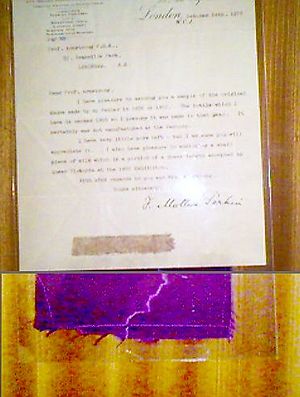Mauveine facts for kids
Mauveine (say: maw-veen) was the very first man-made chemical dye. It was also known as aniline purple or Perkin's mauve. This amazing purple color was discovered by accident in 1856. It changed the world of fashion and led to many other new dyes!
Contents
How Mauveine Was Discovered

In 1856, a young scientist named William Henry Perkin was just 18 years old. His professor, August Wilhelm von Hofmann, gave him a big challenge. He asked Perkin to try and create a medicine called quinine. Quinine was used to treat a disease called malaria.
An Accidental Discovery
Perkin was working in a lab in London. He was trying different ways to make quinine. In one experiment, he mixed a chemical called aniline with another chemical, potassium dichromate. This mix did not make quinine.
When Perkin tried to clean his flask, he used alcohol. He noticed something amazing. The alcohol turned a bright purple color! This purple color was the new dye, Mauveine.
From Lab to Factory
Perkin quickly realized this purple color could be used to dye fabrics. It worked very well on silk and other textiles. He knew he had found something special.
Perkin got a patent for his new dye. A patent means he had the legal right to make and sell it. The very next year, he opened a factory in London. Here, he started making Mauveine in large amounts.
The Rise and Fall of Mauveine
At first, the dye was called aniline purple. Sometimes it was also called Tyrian purple. This was the name of a very old natural purple dye. That ancient dye came from a type of sea snail.
In 1859, the color became known as mauve in England. This name came from the French word for the mallow flower, which is also purple. Later, scientists officially named the dye mauveine.
Mauveine became very popular. Everyone wanted clothes dyed with this new, bright purple. But by 1870, its huge popularity started to fade. Other new man-made dyes were invented. These new dyes offered many more colors. Mauveine was the first, but many more followed!
Scientists did not fully understand the exact chemical structure of mauveine until 1994.
See also
 In Spanish: Mauveína para niños
In Spanish: Mauveína para niños


